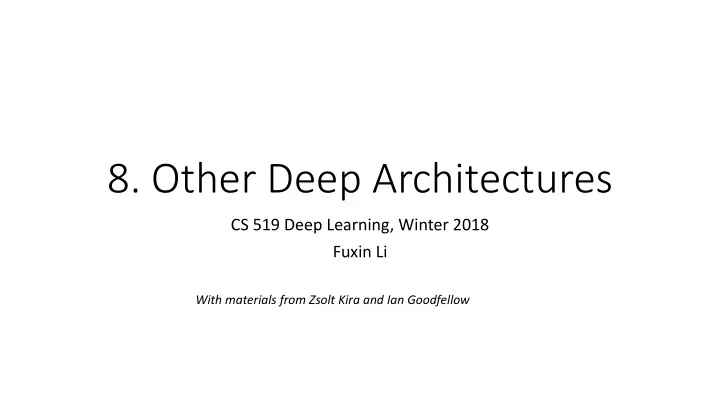

8. Other Deep Architectures CS 519 Deep Learning, Winter 2018 Fuxin Li With materials from Zsolt Kira and Ian Goodfellow
A brief overview of other architectures • Unsupervised Architectures • Deep Belief Networks • Autoencoders • GANs • Temporal Architectures • Recurrent Neural Networks (RNN) • LSTM • We will carefully cover those items later • Right now just a brief overview in case that you might be tempted to use them in your project
Unsupervised Deep Learning • CNN is most successful with a lot of training examples • What can we do if we do not have any training example? • Or have very few of them?
Remember PCA: Characteristics and Limitations • Easy: Can perform Eigen decomposition • Select first K components based on how much variance is capture • Bases are orthogonal • Optimal under some assumptions (Gaussian) • Assumptions almost never true in real data
PCA as a “neural network” • PCA goal: • Minimize reconstruction error 𝑜 𝐖𝐖 ⊤ 𝒚 𝑗 Input vector 2 𝒚 𝒋 − 𝐖𝐖 ⊤ 𝒚 𝑗 min 𝐖 𝑗=1 𝐖 ⊤ 𝒚 𝑗 code 𝒚 𝒋 Input vector
Generalize PCA to multi-layer nonlinear network output vector • Deep Autoencoder • Same as other NN (linear transform + nonlinearity + Many decoding linear transform etc.) layers • Only difference is that after code decoding, strive to reconstruct the original Many encoding input layers • Can have convolutional/fully- input vector connected/sparse versions
Krizhevsky’s deep autoencoder The encoder has 256-bit binary code about 67,000,000 parameters. 512 It takes a few days on 1024 a GTX 285 GPU to train on two million images (Tiny dataset) 2048 4096 8192 1024 1024 1024
Reconstructions of 32x32 color images from 256-bit codes
retrieved using 256 bit codes retrieved using Euclidean distance in pixel intensity space
retrieved using 256 bit codes retrieved using Euclidean distance in pixel intensity space
Generative Adversarial Networks
Generative Adversarial Networks • Cost for the discriminator: • Standard cross-entropy loss, with everything from 𝑞 𝑒𝑏𝑢𝑏 label 1, and everything from 𝑨 label 0 • Cost for the generator: • Try to generate examples to “fool” the discriminator
DCGAN
Samples of DCGAN-generated images
DCGAN representations
Text-to-Image with GANs
Text-to-Image with GANs
Problems
Problems
iGAN https://www.youtube.com/watch?v=9c4z6YsBGQ0
Recurrent Neural Networks (RNNs) • Temporal, Sequences • Tied weights • Some additional variants: Recursive Autoencoders, Long Short-Term Memory (LSTM)
Machine Translation • Have to look at the entire sentence (or, many sentences)
Image Captioning
Restricted Boltzmann Machines • Generative version of the encoder • Binary-valued hidden variables • Define probabilities such as 𝑄 ℎ 𝑗 𝑌 and 𝑄(𝑦 𝑗 |𝐼) • You can generate samples of observed variables from hidden • Think as an extension of probabilistic PCA • Only if you are into generative models (PGM class) • Unsupervised pre-training method to train it (Hinton, Salakhutdinov 2006) • Convolutional and fully connected version available • Doesn’t perform very well..
Fooling a deep network (Szegedy et al. 2013) • Optimizing a delta from the image to maximize a class prediction 𝑔 𝑑 (𝑦) 𝑑 𝐽 + Δ𝐽 − 𝜇||Δ𝐽|| 2 m𝑏𝑦 𝑔 Δ𝐽 Δ𝐽 Shark (93.89% confidence) Giant Panda (99.32% confidence) = +0.03 𝐽 Δ𝐽 Goldfish (95.15% confidence) = +0.03 (Szegedy et al. 2013, Goodfellow et al. 2014, Nguyen et al. 2015)
Recommend
More recommend